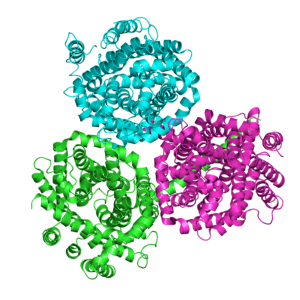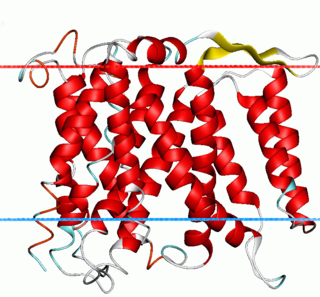Related Research Articles
The Transporter Classification Database is an International Union of Biochemistry and Molecular Biology (IUBMB)-approved classification system for membrane transport proteins, including ion channels.
The sodium/phosphate cotransporter is a member of the phosphate:Na+ symporter (PNaS) family within the TOG Superfamily of transport proteins as specified in the Transporter Classification Database (TCDB).
A neurotransmitter sodium symporter (NSS) (TC# 2.A.22) is type of neurotransmitter transporter that catalyzes the uptake of a variety of neurotransmitters, amino acids, osmolytes and related nitrogenous substances by a solute:Na+ symport mechanism. The NSS family is a member of the APC superfamily. Its constituents have been found in bacteria, archaea and eukaryotes.

Proteins of the Betaine/Carnitine/Choline Transporter (BCCT) family are found in Gram-negative and Gram-positive bacteria and archaea. The BCCT family is a member a large group of secondary transporters, the APC superfamily. Their common functional feature is that they all transport molecules with a quaternary ammonium group [R-N (CH3)3]. The BCCT family proteins vary in length between 481 and 706 amino acyl residues and possess 12 putative transmembrane α-helical spanners (TMSs). The x-ray structures reveal two 5 TMS repeats with the total number of TMSs being 10. These porters catalyze bidirectional uniport or are energized by pmf-driven or smf-driven proton or sodium ion symport, respectively, or else by substrate:substrate antiport. Some of these permeases exhibit osmosensory and osmoregulatory properties inherent to their polypeptide chains.
The Nucleobase:Cation Symporter-1 (NCS1) Family (TC# 2.A.39) consists of over 1000 currently sequenced proteins derived from Gram-negative and Gram-positive bacteria, archaea, fungi and plants. These proteins function as transporters for nucleobases including purines and pyrimidines. Members of this family possess twelve transmembrane α-helical spanners (TMSs). At least some of them have been shown to function in uptake by substrate:H+ symport mechanism.

Members of the Solute:Sodium Symporter (SSS) Family (TC# 2.A.21) catalyze solute:Na+ symport. The SSS family is within the APC Superfamily. The solutes transported may be sugars, amino acids, organo cations such as choline, nucleosides, inositols, vitamins, urea or anions, depending on the system. Members of the SSS family have been identified in bacteria, archaea and eukaryotes. Almost all functionally well-characterized members normally catalyze solute uptake via Na+ symport.
The Nucleobase cation symporter-2 (NCS2) family, also called the Nucleobase ascorbate transporter (NAT) family, consists of over 1000 sequenced proteins derived from gram-negative and gram-positive bacteria, archaea, fungi, plants and animals. The NCS2/NAT family is a member of the APC Superfamily of secondary carriers. Of the five known families of transporters that act on nucleobases, NCS2/NAT is the only one that is most widespread. Many functionally characterized members are specific for nucleobases including both purines and pyrimidines, but others are purine-specific. However, two closely related rat/human members of the family, SVCT1 and SVCT2, localized to different tissues of the body, co-transport L-ascorbate (vitamin C) and Na+ with a high degree of specificity and high affinity for the vitamin. Clustering of NCS2/NAT family members on the phylogenetic tree is complex, with bacterial proteins and eukaryotic proteins each falling into at least three distinct clusters. The plant and animal proteins cluster loosely together, but the fungal proteins branch from one of the three bacterial clusters forming a tighter grouping. E. coli possesses four distantly related paralogous members of the NCS2 family.
Glycine/sarcosine N-methyltransferase is an enzyme with systematic name S-adenosyl-L-methionine:glycine(or sarcosine) N-methyltransferase . This enzyme catalyses the following chemical reaction
The transporter-opsin-G protein-coupled receptor (TOG) superfamily is a protein superfamily of integral membrane proteins, usually of 7 or 8 transmembrane alpha-helical segments (TMSs). It includes (1) ion-translocating microbial rhodopsins and (2) G protein-coupled receptors (GPCRs), (3) Sweet sugar transporters, (4) nicotinamide ribonucleoside uptake permeases (PnuC; TC# 4.B.1), (5) 4-toluene sulfonate uptake permeases (TSUP); TC# 2.A.102), (6) Ni2+–Co2+ transporters (NiCoT); TC# 2.A.52), (7) organic solute transporters (OST); TC# 2.A.82), (8) phosphate:Na+ symporters (PNaS); TC# 2.A.58) and (9) lysosomal cystine transporters (LCT); TC# 2.A.43).
The amino acid-polyamine-organocation (APC) superfamily is the second largest superfamily of secondary carrier proteins currently known, and it contains several Solute carriers. Originally, the APC superfamily consisted of subfamilies under the transporter classification number. This superfamily has since been expanded to include eighteen different families.
The Amino Acid-Polyamine-Organocation (APC) Family of transport proteins includes members that function as solute:cation symporters and solute:solute antiporters. They occur in bacteria, archaea, fungi, unicellular eukaryotic protists, slime molds, plants and animals. They vary in length, being as small as 350 residues and as large as 850 residues. The smaller proteins are generally of prokaryotic origin while the larger ones are of eukaryotic origin. Most of them possess twelve transmembrane α-helical spanners but have a re-entrant loop involving TMSs 2 and 3. The APC Superfamily was established to encompass a wider range of homologues.
The branched chain amino acid:cation symporter (LIVCS) family (TC# 2.A.26) is a member of the APC superfamily. Characterized members of this family transport all three of the branched chain aliphatic amino acids (leucine (L), isoleucine (I) and valine (V)). These proteins are found in Gram-negative and Gram-positive bacteria and function by a Na+ or H+ symport mechanism. They possess about 440 amino acyl residues and display 12 putative transmembrane helical spanners. As of early 2016, no crystal structures for members of the LIVCS family are available on RCSB.
The cation-chloride cotransporter (CCC) family is part of the APC superfamily of secondary carriers. Members of the CCC family are found in animals, plants, fungi and bacteria. Most characterized CCC family proteins are from higher eukaryotes, but one has been partially characterized from Nicotiana tabacum, and homologous ORFs have been sequenced from Caenorhabditis elegans (worm), Saccharomyces cerevisiae (yeast) and Synechococcus sp.. The latter proteins are of unknown function. These proteins show sequence similarity to members of the APC family. CCC family proteins are usually large, and possess 12 putative transmembrane spanners (TMSs) flanked by large N-terminal and C-terminal hydrophilic domains.
The anion exchanger family is a member of the large APC superfamily of secondary carriers. Members of the AE family are generally responsible for the transport of anions across cellular barriers, although their functions may vary. All of them exchange bicarbonate. Characterized protein members of the AE family are found in plants, animals, insects and yeast. Uncharacterized AE homologues may be present in bacteria. Animal AE proteins consist of homodimeric complexes of integral membrane proteins that vary in size from about 900 amino acyl residues to about 1250 residues. Their N-terminal hydrophilic domains may interact with cytoskeletal proteins and therefore play a cell structural role. Some of the currently characterized members of the AE family can be found in the Transporter Classification Database.
The sulfate permease (SulP) family is a member of the large APC superfamily of secondary carriers. The SulP family is a large and ubiquitous family of proteins derived from archaea, bacteria, fungi, plants and animals. Many organisms including Bacillus subtilis, Synechocystis sp, Saccharomyces cerevisiae, Arabidopsis thaliana and Caenorhabditis elegans possess multiple SulP family paralogues. Many of these proteins are functionally characterized, and most are inorganic anion uptake transporters or anion:anion exchange transporters. Some transport their substrate(s) with high affinities, while others transport it or them with relatively low affinities. Others may catalyze SO2−
4:HCO−
3 exchange, or more generally, anion:anion antiport. For example, the mouse homologue, SLC26A6, can transport sulfate, formate, oxalate, chloride and bicarbonate, exchanging any one of these anions for another. A cyanobacterial homologue can transport nitrate. Some members can function as channels. SLC26A3 and SLC26A6 can function as carriers or channels, depending on the transported anion. In these porters, mutating a glutamate, also involved in transport in the CIC family, created a channel out of the carrier. It also changed the stoichiometry from 2Cl−/HCO−
3 to 1Cl−/HCO−
3.
Divalent anion:Na+ symporters were found in bacteria, archaea, plant chloroplasts and animals.

The Monovalent Cation:Proton Antiporter-1 (CPA1) Family (TC# 2.A.36) is a large family of proteins derived from Gram-positive and Gram-negative bacteria, blue-green bacteria, archaea, yeast, plants and animals. The CPA1 family belongs to the VIC superfamily. Transporters from eukaryotes have been functionally characterized to catalyze Na+:H+ exchange. Their primary physiological functions are thought to be in (1) cytoplasmic pH regulation, extruding the H+ generated during metabolism, and (2) salt tolerance (in plants), due to Na+ uptake into vacuoles. Bacterial homologues have also been found to facilitate Na+:H+ antiport, but some also catalyze Li+:H+ antiport or Ca2+:H+ antiport under certain conditions.
The Cation:Proton Antiporter (CPA) Superfamily is a superfamily of transport proteins named after one of its constituent members, the monovalent cation:proton antiporter-2.
The Malonate:Na+ Symporter (MSS) Family (TC# 2.A.70) is a group of transport proteins belonging to the CPA superfamily. These proteins are composites with constituents ranging in size from 129 to 255 amino acyl residues (aas) and exhibiting 4 to 7 transmembrane segments (TMSs). A representative list of proteins belonging to the MSS family can be found in the Transporter Classification Database.
Proton-coupled amino acid transporters belong to the SLC26A5 family; they are protein receptors whose main function is the transmembrane movement of amino acids and their derivatives. This family of receptors is most commonly found within the luminal surface of the small intestine as well as in some lysosomes. The solute carrier family (SLC) of genes includes roughly 400 membrane proteins that are characterized by 66 families in total. The SLC36 family of genes maps to chromosome 11. The diversity of these receptors is vast, with the ability to transport both charged and uncharged amino acids along with their derivatives. In research and practice, SLC36A1/2 are both targets for drug-based delivery systems for a wide range of disorders.
References
- ↑ Bualuang A, Kageyama H, Tanaka Y, Incharoensakdi A, Takabe T (2015). "Functional characterization of a member of alanine or glycine: cation symporter family in halotolerant cyanobacterium Aphanothece halophytica". Bioscience, Biotechnology, and Biochemistry. 79 (2): 230–5. doi:10.1080/09168451.2014.968091. PMID 25421789. S2CID 205616830.
- ↑ Kanamori M, Kamata H, Yagisawa H, Hirata H (March 1999). "Overexpression of the alanine carrier protein gene from thermophilic bacterium PS3 in Escherichia coli". Journal of Biochemistry. 125 (3): 454–9. doi:10.1093/oxfordjournals.jbchem.a022308. PMID 10050032.
- 1 2 Saier MH. "2.A.25 The Alanine or Glycine:Cation Symporter (AGCS) Family". Transporter Classification Database. Saier Lab Bioinformatics Group / SDSC.
- ↑ Ma J, Lei HT, Reyes FE, Sanchez-Martinez S, Sarhan MF, Hattne J, Gonen T (February 2019). "Structural basis for substrate binding and specificity of a sodium-alanine symporter AgcS". Proceedings of the National Academy of Sciences of the United States of America. 116 (6): 2086–2090. doi: 10.1073/pnas.1806206116 . PMC 6369739 . PMID 30659158.